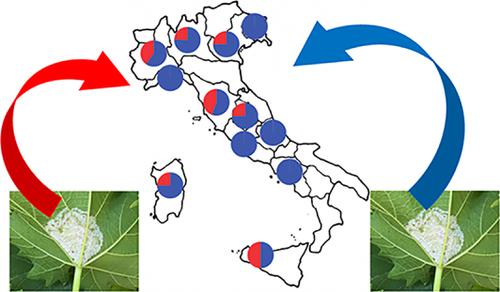当前位置:
X-MOL 学术
›
Ann. Appl. Biol.
›
论文详情
Our official English website, www.x-mol.net, welcomes your
feedback! (Note: you will need to create a separate account there.)
Genetic structure of Italian population of the grapevine downy mildew agent, Plasmopara viticola
Annals of Applied Biology ( IF 2.2 ) Pub Date : 2020-01-09 , DOI: 10.1111/aab.12567 Giuliana Maddalena 1 , François Delmotte 2 , Piero Attilio Bianco 1 , Gabriella De Lorenzis 1 , Silvia Laura Toffolatti 1
Annals of Applied Biology ( IF 2.2 ) Pub Date : 2020-01-09 , DOI: 10.1111/aab.12567 Giuliana Maddalena 1 , François Delmotte 2 , Piero Attilio Bianco 1 , Gabriella De Lorenzis 1 , Silvia Laura Toffolatti 1
Affiliation

|
Downy mildew, caused by the Oomycete Plasmopara viticola, is one of the most important diseases affecting the Eurasian grapevine, Vitis vinifera. The pathogen originated in Northern America and its presence was signalled for the first time into Europe in 1878. In this study, the genetic variability and structure of Italian P. viticola population was investigated by genotyping 106 P. viticola strains belonging to 12 different regions, at 31 microsatellite markers. As a result of the high percentage of missing data, 96 strains and 19 loci were retained for the data analysis. The overall Italian population presents absence of clones, evidence of sexual and asexual reproduction and a low genetic diversity, as expected for an introduced pathogen, but a slightly higher genetic diversity than that found in other European populations, based on allelic diversity at the investigated microsatellite loci. Out of 19 loci, half shows deviation from Hardy–Weinberg equilibrium and, indeed, structure analysis indicates the presence of two separate genetic clusters, with little but significantly different distribution according to geography (west–east gradient) and climatic conditions. Overall, the analysis of the P. viticola population, 140 years after its appearance in Italy, provides indication on the pathogen adaptability. This should be taken into consideration in the future for preserving the durability of disease resistant varieties in open field. In this view, all the disease control methods available should be integrated in order to reduce the selection of pathogen strains able to overcome plant resistance.
中文翻译:

意大利葡萄霜霉病菌Plasmopara viticola的遗传结构
葡萄球菌(Oomycete Plasmopara viticola)引起的霜霉病是影响欧亚葡萄(Vitis vinifera)的最重要疾病之一。该病原体起源于北美,并在1878年首次向欧洲发出信号。在这项研究中,意大利人P的遗传变异和结构。通过对106 P的基因分型来研究葡萄的葡萄种群。属于12个不同区域的葡萄弧菌菌株,位于31个微卫星标记上。由于丢失数据的百分比很高,因此有96个菌株和19个基因座被保留用于数据分析。根据所调查微卫星的等位基因多样性,意大利总体人口没有克隆,没有性繁殖和无性繁殖的证据,遗传多样性低,这是对引入的病原体的预期,但是其遗传多样性比其他欧洲人口更高。位点。在19个位点中,一半显示出偏离Hardy-Weinberg平衡,实际上,结构分析表明存在两个单独的遗传簇,根据地理(西-东梯度)和气候条件,分布几乎没有,但差异显着。总体而言,对P的分析。葡萄在意大利出现140年后,其种群数量表明了病原体的适应性。为了在露天场所保持抗病品种的持久性,将来应考虑到这一点。根据这种观点,应整合所有可用的疾病控制方法,以减少能够克服植物抗性的病原体菌株的选择。
更新日期:2020-01-09
中文翻译:

意大利葡萄霜霉病菌Plasmopara viticola的遗传结构
葡萄球菌(Oomycete Plasmopara viticola)引起的霜霉病是影响欧亚葡萄(Vitis vinifera)的最重要疾病之一。该病原体起源于北美,并在1878年首次向欧洲发出信号。在这项研究中,意大利人P的遗传变异和结构。通过对106 P的基因分型来研究葡萄的葡萄种群。属于12个不同区域的葡萄弧菌菌株,位于31个微卫星标记上。由于丢失数据的百分比很高,因此有96个菌株和19个基因座被保留用于数据分析。根据所调查微卫星的等位基因多样性,意大利总体人口没有克隆,没有性繁殖和无性繁殖的证据,遗传多样性低,这是对引入的病原体的预期,但是其遗传多样性比其他欧洲人口更高。位点。在19个位点中,一半显示出偏离Hardy-Weinberg平衡,实际上,结构分析表明存在两个单独的遗传簇,根据地理(西-东梯度)和气候条件,分布几乎没有,但差异显着。总体而言,对P的分析。葡萄在意大利出现140年后,其种群数量表明了病原体的适应性。为了在露天场所保持抗病品种的持久性,将来应考虑到这一点。根据这种观点,应整合所有可用的疾病控制方法,以减少能够克服植物抗性的病原体菌株的选择。











































 京公网安备 11010802027423号
京公网安备 11010802027423号